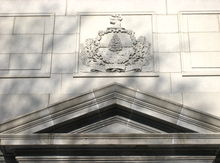Vermont Supreme Court

The Vermont Supreme Court , established in 1841, is the supreme judiciary in the state of Vermont . Unlike most other states, the Vermont Supreme Court rules complaints directly after the courts of first instance. Vermont does not have an intermediate appeals court.
The court consists of the Chief Justice and four Assistant Judges . Appeals from cases decided by other courts are usually brought before the court . Supreme Court justices are appointed by the Vermont Governor and are approved by the Vermont Senate . If a position is vacant, the Judiciary Nominations Committee submits names of suitable candidates to the governor. All Supreme Court justices run for re-election every six years. The next election date is March 31, 2017. The Joint Judicial Affairs Committee will review the performance of the jurisdiction during the previous term and propose re-election to the Vermont General Assembly . The committee consists of four members of the Vermont House of Representatives, appointed by the House Speaker, and four members of the Vermont Senate , appointed by the Committee on Committees. After an open debate and discussion, the assembly elects by secret ballot. A majority must be found that speaks out against a further term of office, otherwise the office holders are re-elected.
In addition to the re-election process, any Vermont judge can be removed from office at any time in one of two ways. Judges can be indicted by a two-thirds majority in the General Assembly and convicted by a two-thirds majority in the Senate, or a judicial committee investigates complaints of judicial misconduct or obstruction and recommends any necessary action to the Supreme Court.
The currently incumbent Chief Justice is Paul L. Reiber . Reiber was appointed Associate Justice to Governor Jim Douglas in October 2003 and then sworn in as Chief Justice on December 17, 2004. Associate judges are John Dooley appointed in 1987 by Madeleine M. Kunin , Marilyn Skoglund appointed in 1997 by Howard Dean , Brian Burgess appointed in 2005 by Jim Douglas and Beth Robinson appointed in 2011 by Peter Shumlin .
The Vermont Supreme Court has administrative control over the judicial system and provides administrative and procedural rules for all courts. The Tribunal is located in a Beaux-Arts architecture building in Montpelier , east of the Vermont State House and immediately west of the governor's government building.
history
The original name of the court was "Council of Censors", which oversaw the court and its members. The council was abolished in 1870.
Notable chief justices include United States Senate Governor and Senator Moses Robinson , Senator Nathaniel Chipman , Governor and Senator Isaac Tichenor , Governor and Senator Jonathan Robinson , playwright Royall Tyler , Governor Richard Skinner , Senator Dudley Chase , Governor Cornelius P Van Ness , Senator Samuel Prentiss , Governor Charles K. Williams , Governor Stephen Royce , Congressman Luke P. Poland , Congressman Homer Royce, and Senator Jonathan Ross .
Olin M. Jeffords, father of Senator Jim Jeffords , served as Chief Justice from 1955 to 1958.
Web links
- Vermont Judiciary Homepage (English)
- Government of Vermont (English)
- List of Vermont Supreme Court Justices
Individual evidence
- ↑ Vermont Nominations , accessed October 9, 2014
- ↑ Retention Evaluation Programs in Vermont , accessed October 9, 2014
- ^ Removal of Justices in Vermont , accessed October 9, 2014
- ↑ Composition of the Vermont Supreme Court , accessed October 9, 2014
- ↑ Biographies of Vermont Supreme Court Justices ( July 8, 2013 memento in the Internet Archive ), accessed October 9, 2014
- ^ Vermont Council of Censors , accessed October 9, 2014
